Models culled from the Binns Road refuse:
Mini Dinky
story and photos by Brian Willoughby
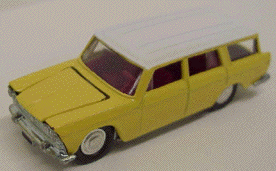 Witnessing the phenomenal success of Lesney's Matchbox Series
and two upstart rivals introduced by Mettoy and Mattel, Mecanno decided
in the late 1960s that it was time for it too to join the ranks of companies
offering a line of small scale, highly detailed, diecast model cars. A few
years earlier, Dinky had halfheartedly attempted to market Matchbox clones
under the name Dinky Dublo. Unfortunately, the high quality models failed
to gain any measurable market share and, in the end, the range was left
to die a very quiet and unlamented death. Yet with several viable competitors
readily eroding Dinky's once dominant position in 1:43 scale diecasts, Mecanno
was eager to exploit market segments in which it was still under represented.
To cash in on the profitable small scale market, Mecanno decided to re-enter
the field by unveiling one of the worst product lines in its long and hitherto
respected history: the Mini Dinky range of 1:65 scale models.
Witnessing the phenomenal success of Lesney's Matchbox Series
and two upstart rivals introduced by Mettoy and Mattel, Mecanno decided
in the late 1960s that it was time for it too to join the ranks of companies
offering a line of small scale, highly detailed, diecast model cars. A few
years earlier, Dinky had halfheartedly attempted to market Matchbox clones
under the name Dinky Dublo. Unfortunately, the high quality models failed
to gain any measurable market share and, in the end, the range was left
to die a very quiet and unlamented death. Yet with several viable competitors
readily eroding Dinky's once dominant position in 1:43 scale diecasts, Mecanno
was eager to exploit market segments in which it was still under represented.
To cash in on the profitable small scale market, Mecanno decided to re-enter
the field by unveiling one of the worst product lines in its long and hitherto
respected history: the Mini Dinky range of 1:65 scale models.
The Mini Dinkies were unique in several aspects. Unlike other Dinky models
produced by the English branch of the company, they were not produced in
the old Liverpool factory located on Binns Road; rather, to maximize profits,
the majority of Mini Dinkies were manufactured in Hong Kong. Subjects selected
to be modeled frequently seemed to be bizarre choices and ranged from a
huge 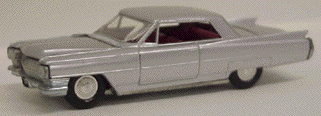 Cadillac Coupe de Ville to a diminutive M.G.B., along with
several other cars that had already been modeled by other manufacturers.
In spite of the sometimes questionable vehicle selections, the detail cut
into the dies was outstanding and the models were very accurate depictions
of the full-scale cars. Nothing less would have been expected from Dinky,
yet unfortunately, one of the major differences distinguishing them from
their larger siblings was their quality of construction. Mini Dinkies were,
from the start, of inferior quality to their larger British (and French)
made counterparts and this represented a most unexpected departure from
the extremely high quality toys for which Mecanno was so long known and
revered.
Cadillac Coupe de Ville to a diminutive M.G.B., along with
several other cars that had already been modeled by other manufacturers.
In spite of the sometimes questionable vehicle selections, the detail cut
into the dies was outstanding and the models were very accurate depictions
of the full-scale cars. Nothing less would have been expected from Dinky,
yet unfortunately, one of the major differences distinguishing them from
their larger siblings was their quality of construction. Mini Dinkies were,
from the start, of inferior quality to their larger British (and French)
made counterparts and this represented a most unexpected departure from
the extremely high quality toys for which Mecanno was so long known and
revered.
The first observation one makes about Mini Dinkies aside from the car
depicted is their dull and lifeless paint. Mini Dinky paint quality was,
at it very best, mediocre and many other less costly Hong Kong diecasts,
such as Mattel's particularly well made Hot Wheels, featured vastly superior
finishes. In a rather dubious accomplishment, even Mini Dinkies sprayed
in metallic colors failed to show any of the "flash and style"
that was so often associated with such finishes during the Swinging '60s.
Irrespective of whether a metallic finish was selected, paint thickness
in general varied from so excessive that it obliterated details in the casting
to so thin that it was sometimes questionable whether the model passed by
the spray jet at all. Additionally, aside from thickness problems, runs
and bubbles were also among the more commonly encountered paint defects.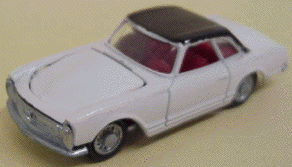
When two paint applications were required on models with, for instance,
a roof of a different color than the remainder of the body, they inevitably
showed over spray from poor masking. Once again, the second application
of paint often produced unsightly runs that bled onto the main color which
itself frequently looked as if it was not allowed to properly cure. Stoplights
were hand-painted in red with results that were as equally sloppy as the
rest of the models' paint work. Curiously, license plates were painted black
through the use of spray guns and masking yet no number-bearing decals were
applied or supplied to finish the job.
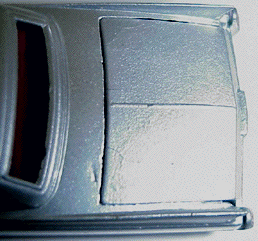 However, the most significant problem with Mini Dinkies was
an age old foe of diecast toys: metal fatigue. Caused by the presence of
contaminants in the zinc alloy from which diecast toys are made, the condition
results in web of hairline cracks that form throughout the casting. Eventually,
fatigued castings can literally crumble into thousands of pieces; nonetheless,
with extremely careful handling, some models can hold together well enough
to be displayed. Many of the Mini Dinky models developed fatigue within
a few years after purchase while others can still be found today with no
detectable signs of this much feared blight: it all depended on the purity
of the alloy. Furthermore, this condition made the many operating features
found on the Mini Dinkies even more apt to breaking or falling off than
they were on other Mini Dinkies not suffering from fatigue. Unfortunately,
and perhaps due to the rarity of this line of toys, fatigued models that
are still in one solid piece inside their original packaging do not seem
to sell for any less than their non-fatigued counterparts.
However, the most significant problem with Mini Dinkies was
an age old foe of diecast toys: metal fatigue. Caused by the presence of
contaminants in the zinc alloy from which diecast toys are made, the condition
results in web of hairline cracks that form throughout the casting. Eventually,
fatigued castings can literally crumble into thousands of pieces; nonetheless,
with extremely careful handling, some models can hold together well enough
to be displayed. Many of the Mini Dinky models developed fatigue within
a few years after purchase while others can still be found today with no
detectable signs of this much feared blight: it all depended on the purity
of the alloy. Furthermore, this condition made the many operating features
found on the Mini Dinkies even more apt to breaking or falling off than
they were on other Mini Dinkies not suffering from fatigue. Unfortunately,
and perhaps due to the rarity of this line of toys, fatigued models that
are still in one solid piece inside their original packaging do not seem
to sell for any less than their non-fatigued counterparts.
Unlike other small-scale diecasts, Mini Dinkies' wheels were not crimped
or riveted onto an axle; rather, their tires and wheels were mounted in
place purely by pressure exerted from the hub around the axle shaft. While
such a wheel and axle system might have been fine for adult collectors,
in the hands of rambunctious boys, the wheels had a propensity for working
loose and being lost. One can only image the fate that befell such wheel-less,
and therefore to their owners "worthless", Mini Dinkies and no
doubt many of them were sentenced to meet up with dad's sledgehammer or
vise. As if their wheel design wasn't already bad enough, yet another flaw
of the Mini Dinkies' design was the unstable rubber compound used for the
tires: over time, it had a tendency to crack and become very shiny, sticky
and brittle.
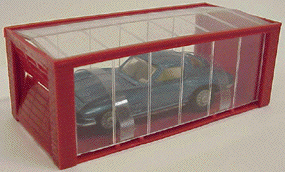 One clever idea that actually worked was the Mini Dinkies'
packaging. Each car came home from the toy store in a small "garage"
that appeared much more like a miniature greenhouse. Their appearance was
due to the clear plastic shell that was inserted into the garage's red plastic
base which allowed the would-be owner to examine the model prior purchase.
Undoubtedly, the see-through garage was perhaps used, in some rare instances,
as a display case at home as well. At the front of the garage was a folding
door that operated somewhat like a real garage door yet two clear plastic
straps threaded through the base kept the model from accidentally falling
out and moving about. Obviously, the idea was to remove the straps and involve
the garage while playing with the cars yet most of them were, much like
Matchbox boxes, thrown away. Not to be left out of the Mini Dinky poor-quality
contest, garages that have survived are often found today with mild warpage
of the red plastic base.
One clever idea that actually worked was the Mini Dinkies'
packaging. Each car came home from the toy store in a small "garage"
that appeared much more like a miniature greenhouse. Their appearance was
due to the clear plastic shell that was inserted into the garage's red plastic
base which allowed the would-be owner to examine the model prior purchase.
Undoubtedly, the see-through garage was perhaps used, in some rare instances,
as a display case at home as well. At the front of the garage was a folding
door that operated somewhat like a real garage door yet two clear plastic
straps threaded through the base kept the model from accidentally falling
out and moving about. Obviously, the idea was to remove the straps and involve
the garage while playing with the cars yet most of them were, much like
Matchbox boxes, thrown away. Not to be left out of the Mini Dinky poor-quality
contest, garages that have survived are often found today with mild warpage
of the red plastic base.
Interestingly, and perhaps not surprisingly when taking into account
their low quality, loose Mini Dinkies in "played with" condition
are infrequent visitors on toy show tables and most models encountered today
are mint in their original packaging. Apparently, only models that served
as "collectibles" rather than as toys enjoyed any kind survival
rate. Furthermore, the pricing of the Mini Dinkies around the time of their
introduction was sufficiently higher than the competition to persuade many
would-be buyers to opt for a less costly Matchbox. Ironically, the Matchbox
was a much better choice in spite of the rather lofty position in which
Dinky products were (and are) placed.
Nevertheless, not everything about the Mini Dinkies was bad: as already
mentioned, the castings were very detailed and well proportioned. Additionally,
the models featured accurate interior moldings and full window glazing along
with two different wheel types that either mimicked a smooth chrome wheel
cover or a set of sporty wires complete with center knock-offs. The opening
features were also nicely executed and tailgates, hoods and doors closed
with minimal gaps around them and revealed well designed engines, steering
wheels and seats inside. Such minute detail was impressive during the late
1960s; sadly, the myriad of other problems plaguing the Mini Dinky range
typically overwhelmed collectors to the point of rarely allowing themselves
to see beyond the defects.
Listing the models produced in the Mini Dinky line is difficult as many
were planned yet few seemed to materialize. Some guidebooks document certain
models as having been produced whereas others do not and books authored
by American writers invariably cite a different group of models as having
been made than what their British counterparts list. Unfortunately, Dinky
catalogues of the period enthused a great deal of optimism for the Mini
Dinky line and all its forthcoming efforts and for this reason, they do
not present a true picture of what actually appeared on the toy shop shelves.
This article has concentrated upon describing only the initial release of
Mini Dinky passenger cars produced in Hong Kong; also remember that a few
racing cars and a rather extensive line of miniature construction equipment
were also sold under the same name.
After acquiring a few examples of Mini Dinkies, the author was disappointed
in their appalling lack of quality yet noticed that none of the traditional
reference works addressed the models' multitude of problems. Rather, most
guidebooks offer merely a small amount of gushing praise and a list of market
values. So finally, here is that supplemental information that seems necessary
to complete the history of Mini Dinky. As such, allow this piece to serve
only as an introduction: if you find, despite all their sins, that you cannot
resist assembling a comprehensive collection of them, many sources are available
for reference. It is, however, doubtful, that any one else will tell just
how shoddy these products were.
 Witnessing the phenomenal success of Lesney's Matchbox Series
and two upstart rivals introduced by Mettoy and Mattel, Mecanno decided
in the late 1960s that it was time for it too to join the ranks of companies
offering a line of small scale, highly detailed, diecast model cars. A few
years earlier, Dinky had halfheartedly attempted to market Matchbox clones
under the name Dinky Dublo. Unfortunately, the high quality models failed
to gain any measurable market share and, in the end, the range was left
to die a very quiet and unlamented death. Yet with several viable competitors
readily eroding Dinky's once dominant position in 1:43 scale diecasts, Mecanno
was eager to exploit market segments in which it was still under represented.
To cash in on the profitable small scale market, Mecanno decided to re-enter
the field by unveiling one of the worst product lines in its long and hitherto
respected history: the Mini Dinky range of 1:65 scale models.
Witnessing the phenomenal success of Lesney's Matchbox Series
and two upstart rivals introduced by Mettoy and Mattel, Mecanno decided
in the late 1960s that it was time for it too to join the ranks of companies
offering a line of small scale, highly detailed, diecast model cars. A few
years earlier, Dinky had halfheartedly attempted to market Matchbox clones
under the name Dinky Dublo. Unfortunately, the high quality models failed
to gain any measurable market share and, in the end, the range was left
to die a very quiet and unlamented death. Yet with several viable competitors
readily eroding Dinky's once dominant position in 1:43 scale diecasts, Mecanno
was eager to exploit market segments in which it was still under represented.
To cash in on the profitable small scale market, Mecanno decided to re-enter
the field by unveiling one of the worst product lines in its long and hitherto
respected history: the Mini Dinky range of 1:65 scale models. Cadillac Coupe de Ville to a diminutive M.G.B., along with
several other cars that had already been modeled by other manufacturers.
In spite of the sometimes questionable vehicle selections, the detail cut
into the dies was outstanding and the models were very accurate depictions
of the full-scale cars. Nothing less would have been expected from Dinky,
yet unfortunately, one of the major differences distinguishing them from
their larger siblings was their quality of construction. Mini Dinkies were,
from the start, of inferior quality to their larger British (and French)
made counterparts and this represented a most unexpected departure from
the extremely high quality toys for which Mecanno was so long known and
revered.
Cadillac Coupe de Ville to a diminutive M.G.B., along with
several other cars that had already been modeled by other manufacturers.
In spite of the sometimes questionable vehicle selections, the detail cut
into the dies was outstanding and the models were very accurate depictions
of the full-scale cars. Nothing less would have been expected from Dinky,
yet unfortunately, one of the major differences distinguishing them from
their larger siblings was their quality of construction. Mini Dinkies were,
from the start, of inferior quality to their larger British (and French)
made counterparts and this represented a most unexpected departure from
the extremely high quality toys for which Mecanno was so long known and
revered.
 However, the most significant problem with Mini Dinkies was
an age old foe of diecast toys: metal fatigue. Caused by the presence of
contaminants in the zinc alloy from which diecast toys are made, the condition
results in web of hairline cracks that form throughout the casting. Eventually,
fatigued castings can literally crumble into thousands of pieces; nonetheless,
with extremely careful handling, some models can hold together well enough
to be displayed. Many of the Mini Dinky models developed fatigue within
a few years after purchase while others can still be found today with no
detectable signs of this much feared blight: it all depended on the purity
of the alloy. Furthermore, this condition made the many operating features
found on the Mini Dinkies even more apt to breaking or falling off than
they were on other Mini Dinkies not suffering from fatigue. Unfortunately,
and perhaps due to the rarity of this line of toys, fatigued models that
are still in one solid piece inside their original packaging do not seem
to sell for any less than their non-fatigued counterparts.
However, the most significant problem with Mini Dinkies was
an age old foe of diecast toys: metal fatigue. Caused by the presence of
contaminants in the zinc alloy from which diecast toys are made, the condition
results in web of hairline cracks that form throughout the casting. Eventually,
fatigued castings can literally crumble into thousands of pieces; nonetheless,
with extremely careful handling, some models can hold together well enough
to be displayed. Many of the Mini Dinky models developed fatigue within
a few years after purchase while others can still be found today with no
detectable signs of this much feared blight: it all depended on the purity
of the alloy. Furthermore, this condition made the many operating features
found on the Mini Dinkies even more apt to breaking or falling off than
they were on other Mini Dinkies not suffering from fatigue. Unfortunately,
and perhaps due to the rarity of this line of toys, fatigued models that
are still in one solid piece inside their original packaging do not seem
to sell for any less than their non-fatigued counterparts. One clever idea that actually worked was the Mini Dinkies'
packaging. Each car came home from the toy store in a small "garage"
that appeared much more like a miniature greenhouse. Their appearance was
due to the clear plastic shell that was inserted into the garage's red plastic
base which allowed the would-be owner to examine the model prior purchase.
Undoubtedly, the see-through garage was perhaps used, in some rare instances,
as a display case at home as well. At the front of the garage was a folding
door that operated somewhat like a real garage door yet two clear plastic
straps threaded through the base kept the model from accidentally falling
out and moving about. Obviously, the idea was to remove the straps and involve
the garage while playing with the cars yet most of them were, much like
Matchbox boxes, thrown away. Not to be left out of the Mini Dinky poor-quality
contest, garages that have survived are often found today with mild warpage
of the red plastic base.
One clever idea that actually worked was the Mini Dinkies'
packaging. Each car came home from the toy store in a small "garage"
that appeared much more like a miniature greenhouse. Their appearance was
due to the clear plastic shell that was inserted into the garage's red plastic
base which allowed the would-be owner to examine the model prior purchase.
Undoubtedly, the see-through garage was perhaps used, in some rare instances,
as a display case at home as well. At the front of the garage was a folding
door that operated somewhat like a real garage door yet two clear plastic
straps threaded through the base kept the model from accidentally falling
out and moving about. Obviously, the idea was to remove the straps and involve
the garage while playing with the cars yet most of them were, much like
Matchbox boxes, thrown away. Not to be left out of the Mini Dinky poor-quality
contest, garages that have survived are often found today with mild warpage
of the red plastic base.